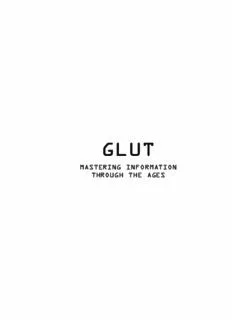Table Of ContentGLUT
MASTERING INFORMATION
THROUGH THE AGES
GLUT
MASTERING INFORMATION
THROUGH THE AGES
ALEX WRIGHT
Joseph Henry Press
Joseph Henry Press
Washington, D.C.
Washington D.C.
Joseph Henry Press 500 Fifth Street, NW Washington, DC 20001
The Joseph Henry Press, an imprint of the National Academies Press,
was created with the goal of making books on science, technology,
and health more widely available to professionals and the public. Jo-
seph Henry was one of the founders of the National Academy of Sci-
ences and a leader in early American science.
Any opinions, findings, conclusions, or recommendations expressed
in this volume are those of the author and do not reflect the views of
the National Academy of Sciences or its affiliated institutions.
Library of Congress Cataloging-in-Publication Data
Wright, Alex, 1966-
Glut : mastering information through the ages / by Alex Wright.
p. cm.
Includes bibliographical references and index.
ISBN 978-0-309-10238-4
1. Information organization—History. 2. Information storage and
retrieval systems—History. 3. Information society—History. I. Title.
Z666.5W75 2007
020.9—dc22
2007006290
Cover design by Michele de la Menardiere.
Copyright 2007 by Alex Wright. All rights reserved.
Printed in the United States of America
For my parents
Our own Middle Age, it has been said, will be an age of
“permanent transition,” for which new methods of adjustment
will have to be employed . . . an immense work of bricolage,
balanced among hope, nostalgia and despair.
Umberto Eco, “Living in the New Middle Ages”
Contents
Introduction 1
1 Networks and Hierarchies 5
2 Family Trees and the Tree of Life 22
3 The Ice Age Information Explosion 39
4 The Age of Alphabets 48
5 Illuminating the Dark Age 78
6 A Steam Engine of the Mind 99
7 The Astral Power Station 122
8 The Encyclopedic Revolution 143
9 The Moose That Roared 152
vii
viii CONTENTS
10 The Industrial Library 165
11 The Web That Wasn’t 183
12 Memories of the Future 230
Appendixes
A John Wilkins’s Universal Categories 239
B Thomas Jefferson’s 1783 Catalog of Books 242
C The Dewey Decimal System 245
D S. R. Ranganathan’s Colon Classification 247
Acknowledgments 251
Notes 253
Index 271
Introduction
Ever since the Web first started to flicker across the world’s computer
screens, we have seen a bull market in hyperbole about the digital age.
Visiting San Francisco at the height of the 1990s dot-com boom, Tom
Wolfe noted the particular brand of euphoria then sweeping the city.
Wolfe, who made his journalistic bones chronicling the raptures of
the city’s psychedelic pranksters in the 1960s,1 spotted a similar strain
of quasi-mystical fervor taking hold among the young acolytes of the
digital revolution. “Much of the sublime lift came from something
loftier than overnight IPO billions,” he wrote, “something verging on
the spiritual.” Enthusiastic dot-commers “were doing more than sim-
ply developing computers and creating a new wonder medium, the
Internet. Far more. The Force was with them. They were spinning a
seamless web over all the earth.”2 In the Day-Glo pages of Wired and
a host of also-ran New Economy magazines, the so-called digerati were
pumping a rhetorical bubble no less inflated than the era’s IPO-fu-
eled stock prices. Writer Steven Johnson compared the dawning age
of software to a religious awakening, predicting that “the visual meta-
phors of interface design will eventually acquire a richness and pro-
fundity that rival those of Hinduism or Christianity.”3 Elsewhere,
supercomputer pioneer Danny Hillis argued that the advent of the
1
2 GLUT
World Wide Web signaled an evolutionary event on par with the
emergence of a new species: “We’re taking off,” he wrote. “We are not
evolution’s ultimate product. There’s something coming after us, and
I imagine it is something wonderful. But we may never be able to
comprehend it, any more than a caterpillar can imagine turning into
a butterfly.”4 More recently, inventor and futurist Ray Kurzweil has
gone so far as to suggest that we are undergoing a “technological
change so rapid and profound it represents a rupture in the fabric of
human history,” an event so momentous that it will trigger “the
merger of biological and nonbiological intelligence, immortal soft-
ware-based humans, and ultra-high levels of intelligence that expand
outward in the universe at the speed of light.”5 Could the arhats
themselves have painted a more dazzling picture of enlightenment?
Mystical beliefs about technology are nothing new. In 1938 H. G.
Wells predicted that “the whole human memory can be, and prob-
ably in a short time will be, made accessible to every individual,”
forming a so-called World Brain that would eventually give birth to a
“widespread world intelligence conscious of itself.”6 Similar visions
of an emerging planetary intelligence surfaced in the mid-twentieth
century writings of the Catholic mystic Teilhard de Chardin, who
foresaw the rise of an “extraordinary network of radio and television
communication which already links us all in a sort of ‘etherised’ hu-
man consciousness” that would ultimately metamorphize into “a
single, organized, unbroken membrane over the earth.”7 Teilhard be-
lieved that this burgeoning networked consciousness signaled a new
stage in God’s evolutionary plan, in which human beings would coa-
lesce into a new kind of social organism, complete with a nervous
system and brain that would eventually spring to life of its own ac-
cord. Teilhard never published his writings—the Catholic Church for-
bade him from doing so—but his essays nonetheless found an
enthusiastic cult following among fellow Jesuits like Marshall
McLuhan, who took Teilhard’s vision as a starting point for formulat-
ing his theory of the global village.
Today, the torch song of technological transcendentalism has
passed from the visionary fringe into the cultural mainstream.
Scarcely a day goes by without some hopeful dispatch about new Web
Description:What do primordial bacteria, medieval alchemists, and the World Wide Web have to do with each other? This fascinating exploration of how information systems emerge takes readers on a provocative journey through the history of the information age. Today's "information explosion" may seem like an acut

